作者:damyxu,腾讯 PCG 前端开发工程师
iframe是一个天然的微前端方案,但受限于跨域的严格限制而无法很好的应用,本文介绍一种基于 iframe 的全新微前端方案,继承iframe的优点,补足 iframe 的缺点,让 iframe 焕发新生。
背景
前端开发中我们对iframe已经非常熟悉了,那么iframe的作用是什么?可以归纳如下:
在一个web应用中可以独立的运行另一个web应用
这个概念已经和微前端不谋而合,相对于目前配置复杂、高适配成本的微前端方案来说,采用iframe方案具有一些显著的优点:
- 非常简单,使用没有任何心智负担
- 隔离完美,无论是 js、css、dom 都完全隔离开来
- 多应用激活,页面上可以摆放多个iframe来组合业务
但是开发者又厌恶使用iframe,因为缺点也非常明显:
- 路由状态丢失,刷新一下,iframe 的 url 状态就丢失了
- dom 割裂严重,弹窗只能在 iframe 内部展示,无法覆盖全局
- 通信非常困难,只能通过 postmessage 传递序列化的消息
- 白屏时间太长,对于SPA 应用应用来说无法接受
能否打造一个完美的iframe,保留所有的优点的同时,解决掉所有的缺点呢?
无界方案
无界微前端框架通过继承iframe的优点,解决iframe的缺点,打造一个接近完美的iframe方案。
来看无界如何一步一步的解决iframe的问题,假设我们有 A 应用,想要加载 B 应用:
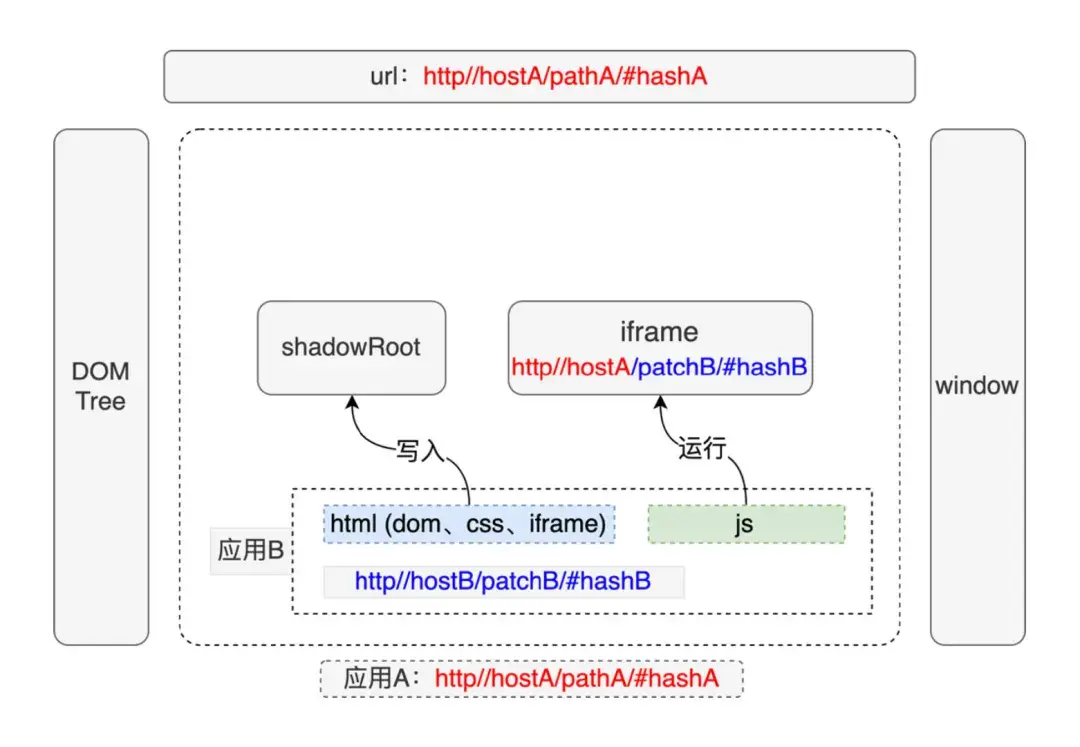
在应用 A 中构造一个shadow和iframe,然后将应用 B 的html写入shadow中,js运行在iframe中,注意iframe的url,iframe保持和主应用同域但是保留子应用的路径信息,这样子应用的js可以运行在iframe的location和history中保持路由正确。
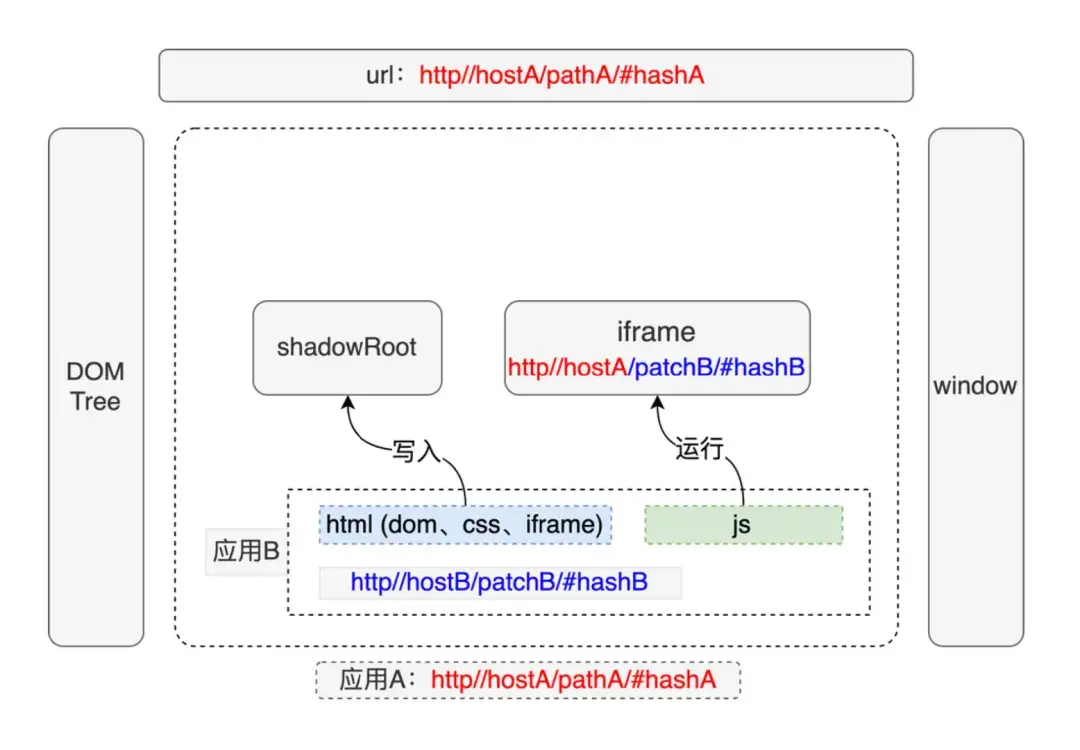
image-20211206160113792
在iframe中拦截document对象,统一将dom指向shadowRoot,此时比如新建元素、弹窗或者冒泡组件就可以正常约束在shadowRoot内部。

接下来的三步分别解决iframe的三个缺点:
- ✅ dom 割裂严重的问题,主应用提供一个容器给到shadowRoot插拔,shadowRoot内部的弹窗也就可以覆盖到整个应用 A
- ✅ 路由状态丢失的问题,浏览器的前进后退可以天然的作用到iframe上,此时监听iframe的路由变化并同步到主应用,如果刷新浏览器,就可以从 url 读回保存的路由
- ✅ 通信非常困难的问题,iframe和主应用是同域的,天然的共享内存通信,而且无界提供了一个去中心化的事件机制
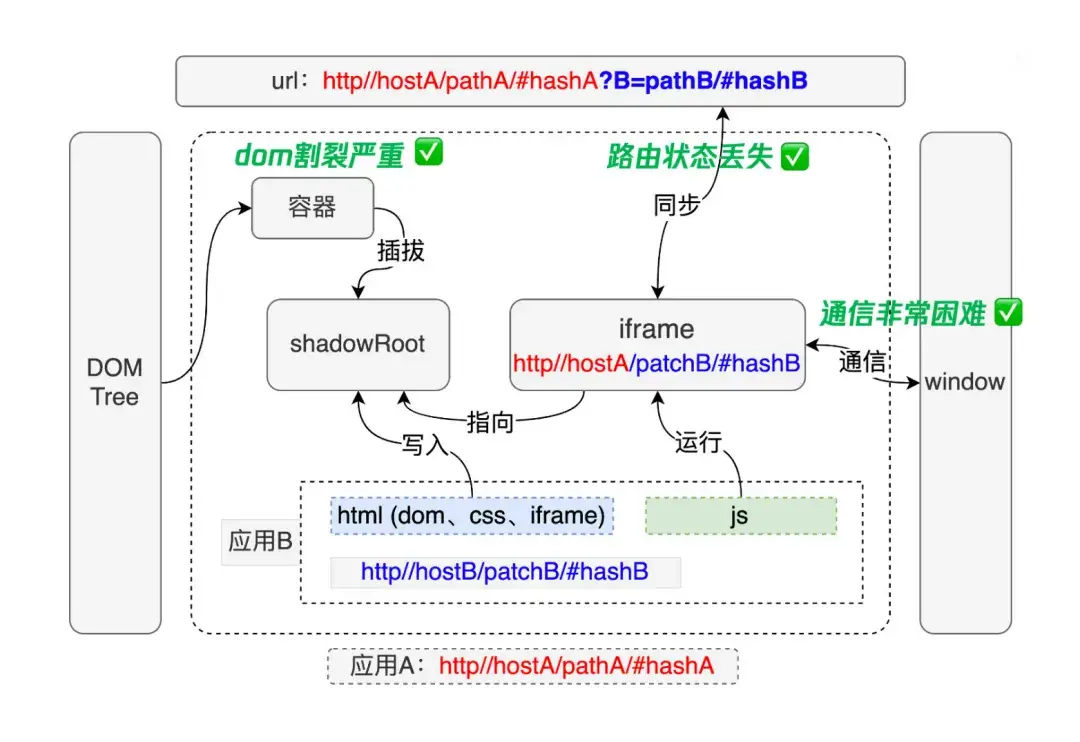
将这套机制封装进wujie框架:

我们可以发现:
- ✅ 首次白屏的问题,wujie实例可以提前实例化,包括shadowRoot、iframe的创建、js的执行,这样极大的加快子应用第一次打开的时间
- ✅ 切换白屏的问题,一旦wujie实例可以缓存下来,子应用的切换成本变的极低,如果采用保活模式,那么相当于shadowRoot的插拔
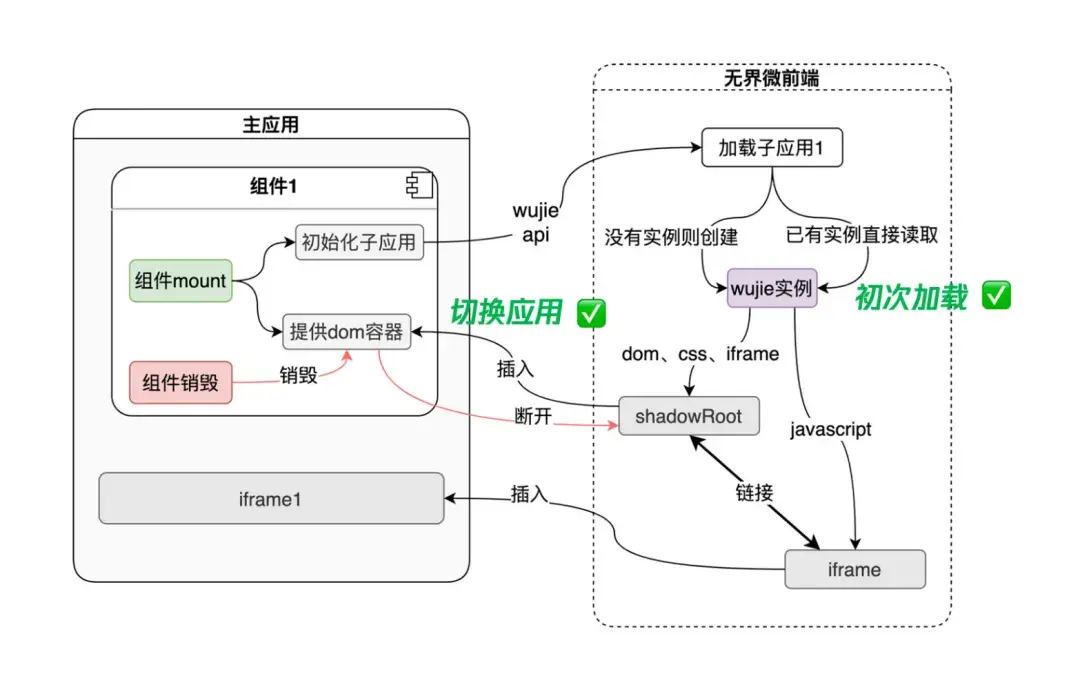
image-20211206160227875
由于子应用完全独立的运行在iframe内,路由依赖iframe的location和history,我们还可以在一张页面上同时激活多个子应用,由于iframe和主应用处于同一个top-level browsing context,因此浏览器前进、后退都可以作用到到子应用:
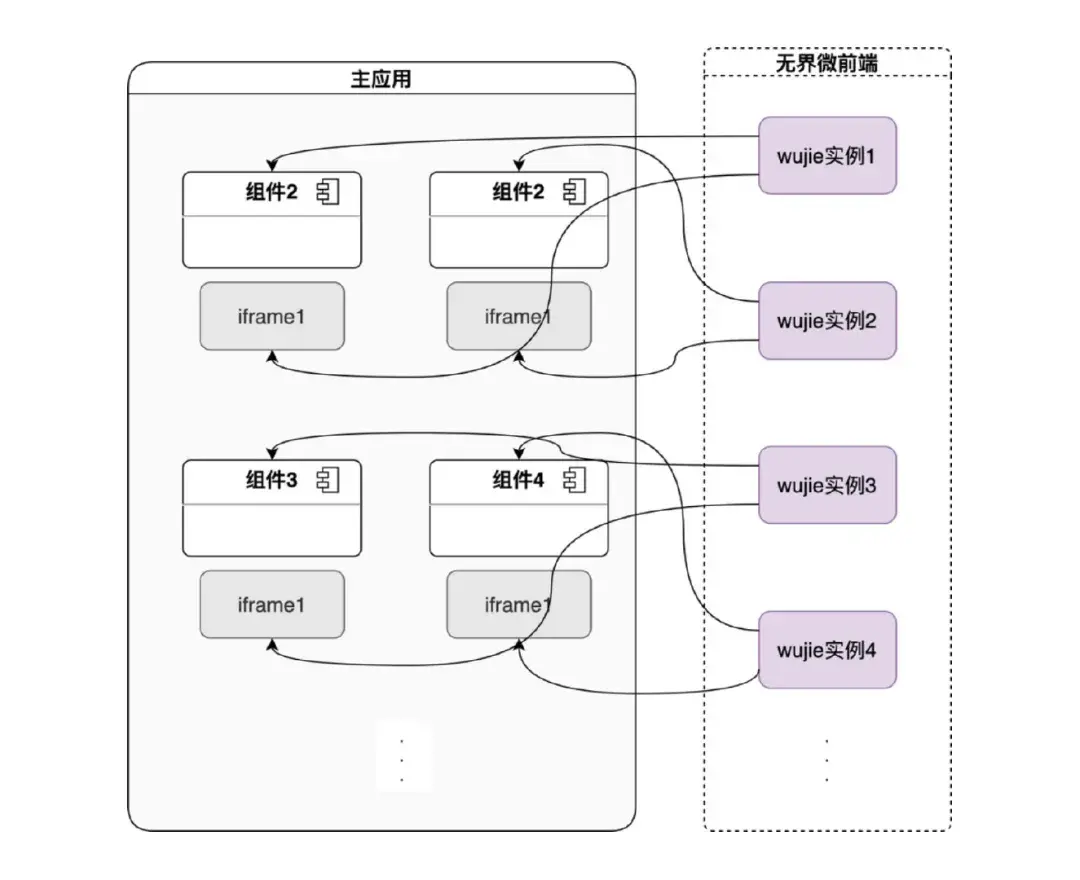
image-20211206160244704
通过以上方法,无界方案可以做到:
- ✅ 非常简单,使用没有任何心智负担
- ✅ 隔离完美,无论是 js、css、dom 都完全隔离开来
- ✅ 多应用激活,页面上可以摆放多个iframe来组合业务
- 路由状态丢失,刷新一下,iframe 的 url 状态就丢失了
- dom 割裂严重,弹窗只能在 iframe 内部展示,无法覆盖全局
- 通信非常困难,只能通过 postmessage 传递序列化的消息
- 白屏时间太长,对于SPA 应用应用来说无法接受
使用无界
如果主应用是vue框架:
安装
`npm i @tencent/wujie-vue -S`引入
mport WujieVue from "@tencent/wujie-vue";Vue.use(WujieVue);使用
<WujieVue width="100%" height="100%" name="xxx" url="xxx" :sync="true" :fetch="fetch" :props="props" @xxx="handleXXX"></WujieVue>其他框架也会在近期上线
适配成本
无界的适配成本非常低
对于主应用无需做任何改造
对于子应用:
- 前提,必须开放跨域配置,因为子应用是在主应用域内请求和运行的
- 对webpack应用,修改动态加载路径
- 如果子应用保活模式则无需进一步修改,非保活则需要将实例化挂载到无界生命周期内
if (window.__POWERED_BY_WUJIE__) { let instance; window.__WUJIE_MOUNT = () => { instance = new Vue({ router, render: (h) => h(App) }).$mount("#app"); }; window.__WUJIE_UNMOUNT = () => { instance.$destroy(); };} else { new Vue({ router, render: (h) => h(App) }).$mount("#app");}实现细节
实现一个纯净的 iframe
子应用运行在一个和主应用同域的iframe中,设置src为替换了主域名host的子应用url,子应用路由只取location的pathname和hash
但是一旦设置src后,iframe由于同域,会加载主应用的html、js,所以必须在iframe实例化完成并且还没有加载完html时中断加载,防止污染子应用
此时可以采用轮询监听document.readyState状态来及时中断,对于一些浏览器比如safari状态不准确,可以在wujie主动抛错来防止有主应用的js运行
iframe 数据劫持和注入
子应用的代码 code 在 iframe 内部访问 window,document、location 都被劫持到相应的 proxy,并且还会注入$wujie对象供子应用调用
const script = `(function(window, self, global, document, location, $wujie) { ${code}\n }).bind(window.__WUJIE.proxy)( window.__WUJIE.proxy, window.__WUJIE.proxy, window.__WUJIE.proxy, window.__WUJIE.proxy.document, window.__WUJIE.proxy.location, window.__WUJIE.provide );`;iframe 和 shadowRoot 副作用的处理
iframe 内部的副作用处理在初始化iframe时进行,主要分为如下几部
/** * 1、location劫持后的数据修改回来,防止跨域错误 * 2、同步路由到主应用 */patchIframeHistory(iframeWindow, appPublicPath, mainPublicPath);/** * 对window.addEventListener进行劫持,比如resize事件必须是监听主应用的 */patchIframeEvents(iframeWindow);/** * 注入私有变量 */patchIframeVariable(iframeWindow, appPublicPath);/** * 将有DOM副作用的统一在此修改,比如mutationObserver必须调用主应用的 */patchIframeDomEffect(iframeWindow);/** * 子应用前进后退,同步路由到主应用 */syncIframeUrlToWindow(iframeWindow);ShadowRoot 内部的副作用必须进行处理,主要处理的就是shadowRoot的head和body
shadowRoot.head.appendChild = getOverwrittenAppendChildOrInsertBefore({ rawDOMAppendOrInsertBefore: rawHeadAppendChild }) as typeof rawHeadAppendChild shadowRoot.head.insertBefore = getOverwrittenAppendChildOrInsertBefore({ rawDOMAppendOrInsertBefore: rawHeadInsertBefore as any }) as typeof rawHeadInsertBefore shadowRoot.body.appendChild = getOverwrittenAppendChildOrInsertBefore({ rawDOMAppendOrInsertBefore: rawBodyAppendChild }) as typeof rawBodyAppendChild shadowRoot.body.insertBefore = getOverwrittenAppendChildOrInsertBefore({ rawDOMAppendOrInsertBefore: rawBodyInsertBefore as any }) as typeof rawBodyInsertBefore
getOverwrittenAppendChildOrInsertBefore主要是处理四种类型标签:
- link/style标签收集stylesheetElement并用于子应用重新激活重建样式
- script标签动态插入的script标签必须从ShadowRoot转移至iframe内部执行
- iframe标签修复iframe的指向对应子应用iframe的window
iframe 的 document 改造
由于js在iframe运行需要和shadowRoot,包括元素创建、事件绑定等等,将iframe的document进行劫持:
- 所有的元素的查询全部代理到shadowRoot内去查询
- head和body代理到shadowRoot的对应html元素上
iframe 的 location 改造
将iframe的location进行劫持:
- 由于iframe的url的host是主应用的,所以需要将host改回子应用自己的
- 对于location.href特殊逻辑的处理
总结
通过上面原理以及细节的阐述,我们可以得出无界微前端框架的几点优势:
- 多应用同时激活在线框架具备同时激活多应用,并保持这些应用路由同步的能力
- 组件式的使用方式无需注册,更无需路由适配,在组件内使用,跟随组件装载、卸载
- 应用级别的 keep-alive子应用开启保活模式后,应用发生切换时整个子应用的状态可以保存下来不丢失,结合预执行模式可以获得类似ssr的打开体验
- 纯净无污染
- 无界利用iframe和ShadowRoot来搭建天然的js隔离沙箱和css隔离沙箱
- 利用iframe的history和主应用的history在同一个top-level browsing context来搭建天然的路由同步机制
- 副作用局限在沙箱内部,子应用切换无需任何清理工作,没有额外的切换成本
- 性能和体积兼具
- 子应用执行性能和原生一致,子应用实例instance运行在iframe的window上下文中,避免with(proxyWindow){code}这样指定代码执行上下文导致的性能下降,但是多了实例化iframe的一次性的开销,可以通过proloadApp提前实例化
- 包体积只有11kb,非常轻量,借助iframe和ShadowRoot来实现沙箱,极大的减小了代码量
- 开箱即用不管是样式的兼容、路由的处理、弹窗的处理、热更新的加载,子应用完成接入即可开箱即用无需额外处理,应用接入成本也极低
相应的也有所不足:
- 内存占用较高,为了降低子应用的白屏时间,将未激活子应用的shadowRoot和iframe常驻内存并且保活模式下每张页面都需要独占一个wujie实例,内存开销较大
- 兼容性一般,目前用到了浏览器的shadowRoot和proxy能力,并且没有做降级方案
- iframe劫持document到shadowRoot时,某些第三方库可能无法兼容导致穿透
 鲁公网安备37020202000738号
鲁公网安备37020202000738号